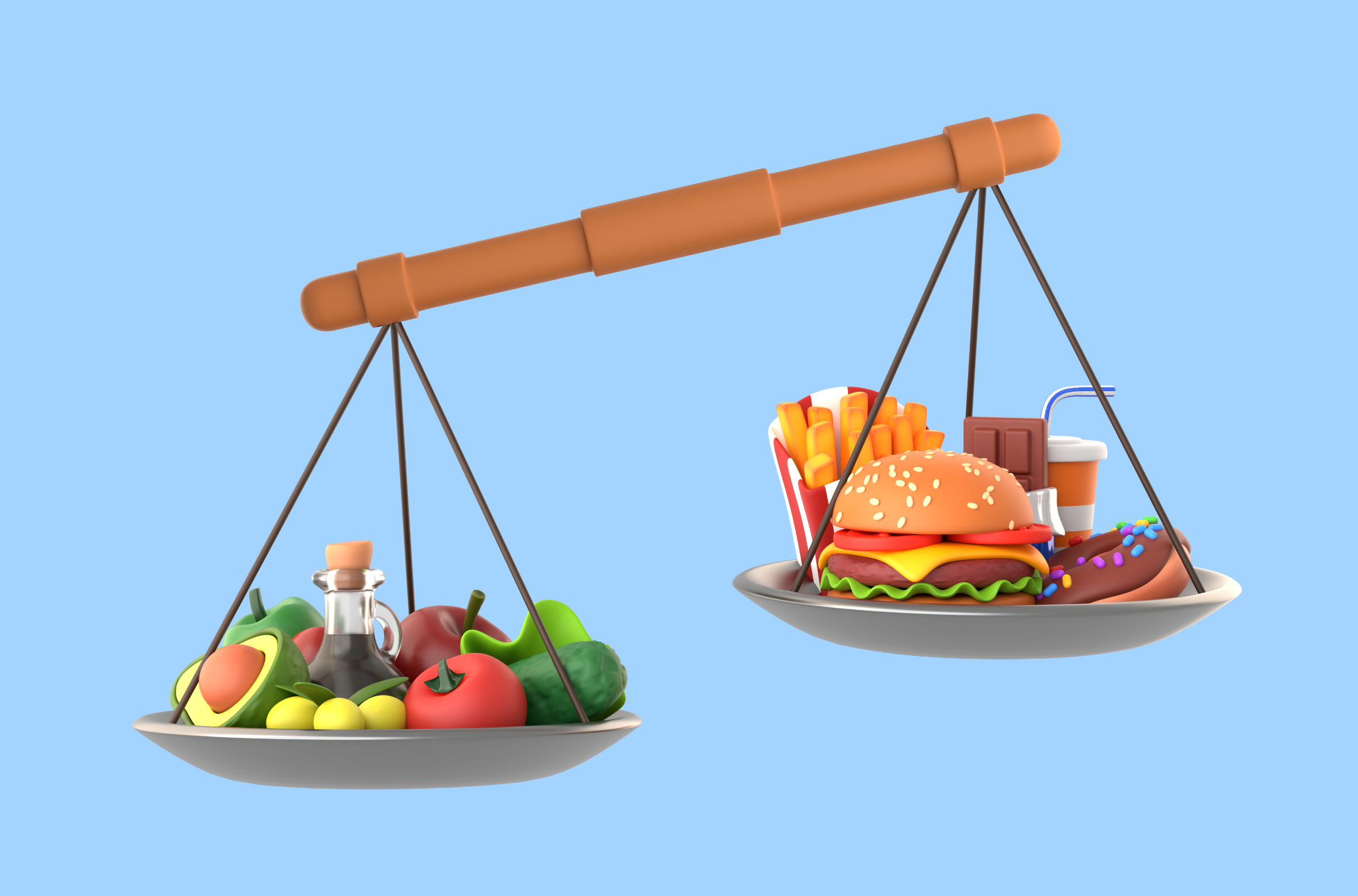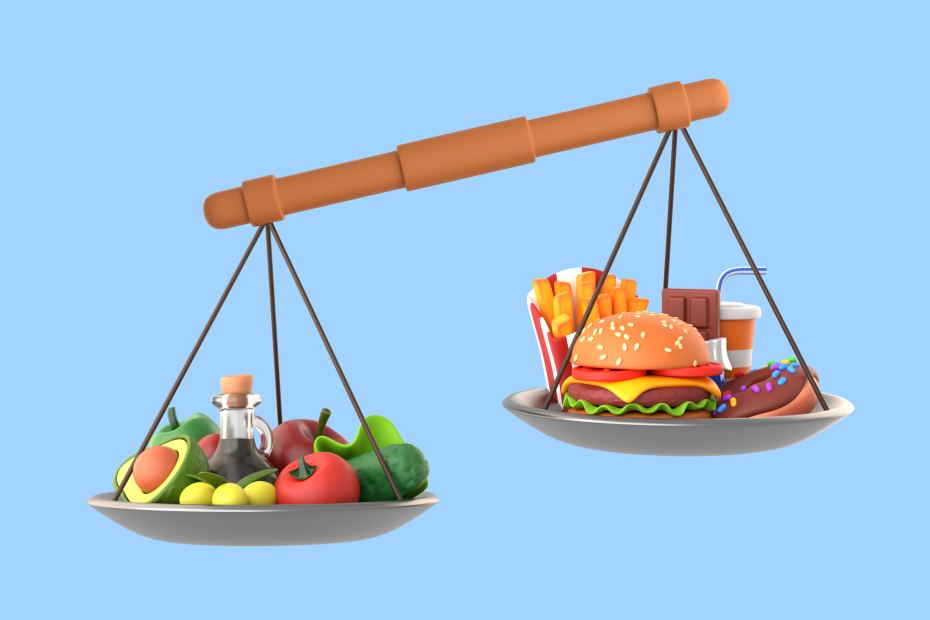Many parents of young children know that getting their kids to eat anything but cheese pizza and chicken nuggets can be an uphill battle. “You have to eat a balanced diet,” parents say, for the millionth time, exasperated.
But what exactly is a balanced diet? And why is it important? Well, in the case of pizza and nuggets, while cheese has fat and calcium, chicken has protein, and crust and breading provide carbohydrates, a diet of only those nutrients would leave a lot of important ones out. (Sorry, kids.)
Fun fact: Some of the earliest evidence of balance scales comes from Egypt around 2500 BC. This evidence is in the form of weights from balance scales. This more recent image, of the jackal-headed god Anubis with a balance scale, is from a papyrus manuscript from around 1300 BC.

To function well, our bodies need a mix of proteins, carbohydrates, fats, and vitamins and minerals, not to mention fiber. Getting a healthy mix of these nutrients requires eating a wide variety of foods.
The US Department of Agriculture (USDA) offers guidance on how to do this, with a feature called “My Plate.” (This is an updated version of what you may remember as the food pyramid.) The plate shows four major food groups: fruits, vegetables, grains, and protein—plus, off to the side, a smaller portion of dairy.
The general idea is this:
- Half of your plate should be vegetables and fruits (these a great source of fiber)
- One-quarter should be whole grains (or things made from whole grains)
- One-quarter should be proteins, such as seafood, poultry, and beans
- Dairy should play a smaller role overall. Think of it as a side dish rather than a main course.
Overall, it’s better to choose:
- A variety of colorful vegetables and fruits (“eat the rainbow”) rather than the same few all the time. This ensures that we get a mix of vitamins and minerals.
- Whole foods over processed, refined foods (for example, brown rice rather than white rice). This is because refining can remove nutritious elements, such as a fibrous outer layer or vitamin- and mineral-rich inner layer.
- Unsaturated fat over saturated fat (for example, olive oil or soybean oil rather than butter or lard).
So what might a week of a balanced diet look like? Below is an example from the Mount Sinai Health System (they have a month of meal plans, if you’d like more ideas). Start by just reading the menus and noticing the ingredients. Maybe picture the foods as you read the names. The point is to not get overwhelmed by the number of different ideas. Notice if there are ideas you hadn’t considered (“Oh, cottage cheese for breakfast. That wouldn’t have occurred to me.”)
Please note the menu ideas here reflect mostly “Western” meals. If your background is from a non-Western culture, you may find it helpful to think about what in your culture might represent a similar diversity of foods, while still fitting the MyPlate recommendations of filling half the plate with vegetables and fruits, one-quarter with whole grains, one-quarter with protein, and a small portion of dairy.
You’ll also notice that the meals are all things people can make at home. None of the meals include prepared foods, such as frozen pizza or store-bought rotisserie chicken. (These foods are often referred to as “processed foods.”)
The reason for this is that prepared/processed foods tend to be less healthy than home-cooked foods, and often contain more salt, sugar, fat, preservatives, and other less-desirable ingredients. Ideally, we would all eat mostly home-cooked meals, made from scratch, with fresh and unprocessed ingredients. But that may not be realistic for many of people. So, we encourage you to do what you can to reduce processed foods in your life. You may find it helpful to read about Nutrition Labels, to explore how to make healthier choices about any processed or packaged foods you do buy.
Eating Out
Restaurant meals also tend to be higher in salt, fat, and other less-than-healthy ingredients than home-cooked ones. But it’s hard to avoid ever eating in a restaurant, nor would most of us want to avoid it. That said, there are ways to make healthier choices when ordering off restaurant menus, as discussed in How to Eat Healthy While Eating Out.
Most people are busy, and it’s hard to make time to incorporate new foods into our routines. So be patient with yourself and start small if you need to—maybe choose just a day or two per week to try new things. Or try replacing a staple of your diet with a healthier option. For example, if you eat a lot of refined white rice, try brown rice. Or replace regular pasta with whole grain pasta.
Here are some other ideas to try:
- Mashed avocado or hummus instead of mayonnaise.
- Peanut butter instead of processed lunchmeat.
- Sweet potatoes or yams instead of russet potatoes.
- Peanut butter with apple slices instead of bread.
- A handful of nuts or a piece of fruit instead of chips.
- Add some nuts and berries to your breakfast oatmeal or yogurt.
Pro Tip: Research shows that it’s hard to make a lot of changes all at once, and have them stick for the long term. The Centers for Disease Control and Prevention (CDC) has some suggestions about making changes that might be helpful:
REFLECT on all of your specific eating habits, both bad and good; and, your common triggers for unhealthy eating.
REPLACE your unhealthy eating habits with healthier ones.
REINFORCE your new, healthier eating habits. Be careful not to berate yourself or think that one mistake “blows” a whole day’s worth of healthy habits. You can do it! It just takes one day at a time!
A Closer Look: Nutrition
If you want to get into the details of how much nutrition you need, check out You Are What You Eat. And for more information on how to evaluate processed foods, see Nutrition Labels.
Sources:
Centers for Disease control (improving your eating habits)
Harvard School of Public Health (processed foods)
Mount Sinai (meal plans)
USDA (MyPlate)
 share
share



